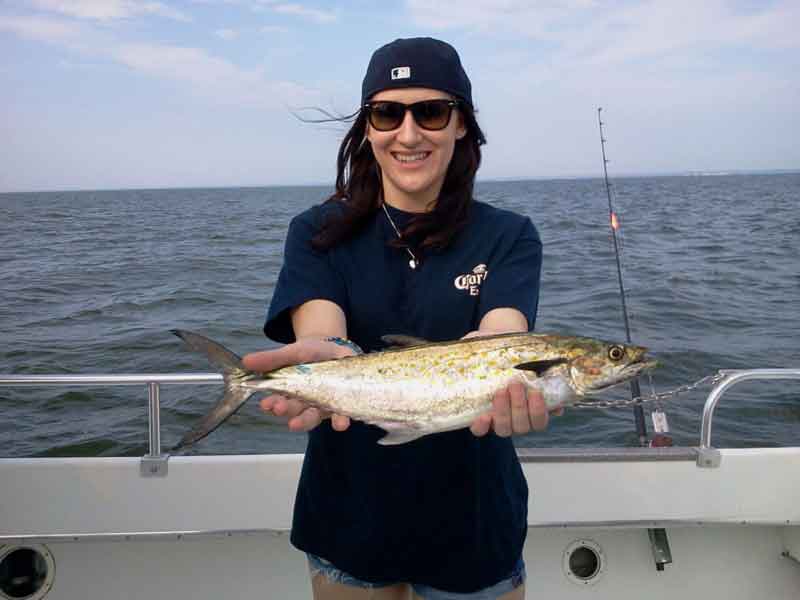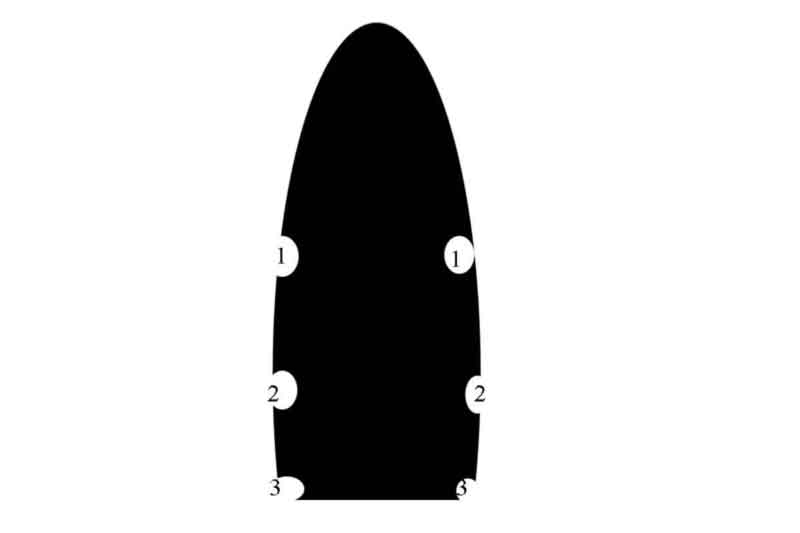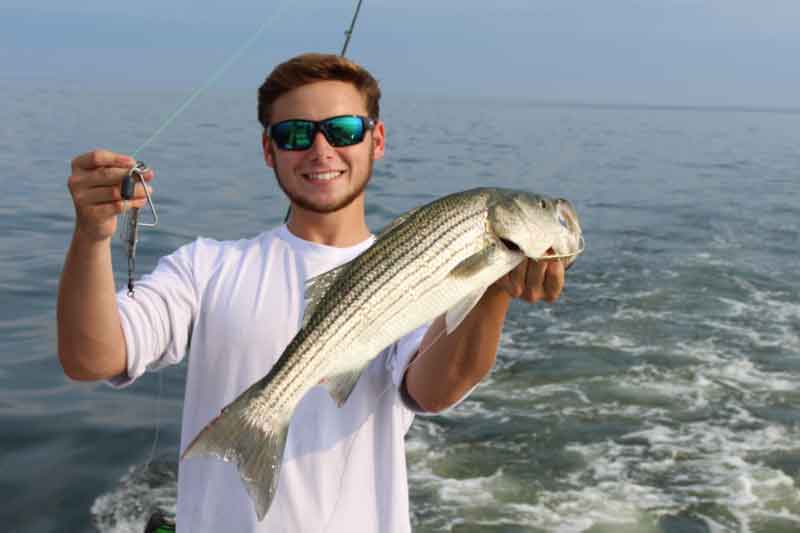Most of you will fondly remember last summer’s Spanish mackerel run, which was the best I can ever remember on the Chesapeake Bay. Almost every time I say that, whoever I’m talking with responds by saying “me, too.” One of those people is Drew Payne, better known simply as “Worm,” the captain of the Big Worm. But Payne also told me that his mission is to put his clients on as many fish and as many different species as possible, each and every trip. And as great as the mackerel fishing was, he liked putting keeper striped bass into the box last summer, too. As our discussion went deeper — and I learned a thing or two I hadn’t heard before — I realized this was a conversation that FishTalk readers would want in on.

Rudow: Sure, you’ll pick up some stripers while trolling for mackerel, but everyone knows the faster speeds you need to troll to get the macks isn’t exactly ideal for stripers. How can you target them at the same time?
Worm: Speed up! Slow down! Who says you have to go one speed all day? Start by trolling fast to cover a lot of ground and find some fish. Now let’s say you see a pod of fish and you think there are mackerel in there. Keep going fast, maybe six knots, and see if you can get a couple mackerel on the lines. There’s fish on? Now pull back the throttles and slow up to around 3.5. Those fish on the line are like two birds in the bush and slowing down gives you a better chance of getting them into your hands. And while you’re going slower, you also have a better chance of hooking up the rockfish. Try this two or three times skirting the school, and if you don’t get mackerel pull back on the throttles and try a slow pass to give rockfish more of a chance. Remember that 90 percent of the time the rockfish in that school are likely to be 15-inch fish and you don’t want to catch them all day. No Spanish, and no good rock? Try going straight through the school. I know some people boo-hoo when you do that, but sometimes you just have to in order to get the bites. So try skirting the school first, its nice to be polite, but know that you might have to go right through it if you want to get fish on the lines. If you’re still not happy with what you’re catching, leave that school and look for another one.
Rudow: I think I’ve noticed that over the years, the schools seem to go down faster these days regardless of how you do or don’t go through them. The schools seem smaller and scattered and pop up and down a lot more than they did a decade or more ago.
Worm: They sure do, and that’s a good argument to keep your speed up and cover ground between schools, or when you leave one that’s just little 15-inch rock to try and find a better school. But don’t forget to use your meter. I can’t tell you how many times I’ve seen boats run to a flock of birds, the birds scatter, then they regroup somewhere else and the boats all start running again. When you find a school with quality fish and then the birds scatter, instead of leaving, keep trolling that area a bit and look at your meter. You think those fish just disappeared? Heck no. They’re still around somewhere, maybe they just moved along a shelf or chased the bait in one direction or another so look around a little bit before you go zooming off to a different school. Which by the way could be all tiny fish for all you know. And another thing: if you’re trolling fast to cover ground and look for mackerel and you see marks that look like rockfish on the meter, well then pull back on those throttles. Don’t just keep going fast because everyone says you have to go fast all the time when mackerel are around.

Rudow: What about the spoons? Do you mix up the sizes to attract both stripers and Spanish?
Worm: Yes, but this is a double-edged sword. Size zero Drone spoons are the ideal for mackerel, but not so much for rockfish. Size two is better for rockfish, they’ll eat them up all day long, but not so much for mackerel. So my lines are arranged to catch both. But let’s say I have a lot of mackerel in the box, maybe I’ll switch some number ones to number twos. I hit my rockfish limit? All zeros go on the lines. You know what I mean — there has to be a method to the madness. You can’t just go out there and troll around the same way with the same stuff all day long and hope for the best.
Rudow: Let’s talk rigging. Do you do anything different when you’re trying to get both stripers and mackerel?
Worm: Look, planers are a must, everyone knows that. And when you’re trolling planers, I’ll say it again: there must be a method to the madness. Otherwise, ho-boy the tangles… Here’s how it goes for six lines, that’s what I’ll be pulling on the Big Worm:

- Number three planer lines go up forward, with just 15 feet of leader. If it’s any longer and the planer trips, the spoon will magically find one of your other lines and you’ll have a massive tangle. These lines are best for Spanish, they don’t mind hitting close to the boat, so use them with a number zero Drone. But mackerel are leader shy, so use 20-pound fluorocarbon for the leaders.
- Number two planers in the middle, with 20 or 25 feet of 20- or 30-pound test leader. These lines catch both species of fish so give them a number one Drone.
- Number one planers in the corners, with 25 feet of 20- or 30-pound test leader. These will be your best rods or the rockfish, so give them number 1.5 or number two Drones.
And this is critical: you need to have a ball-bearing swivel in the middle of your leader, and also on the back of the planer. Both of these swivels are mandatory. Not cheap ones, but real ball-bearing swivels or your 25-foot leaders will be a three-foot-long ball of twist in no time. By the way, the front half of the leader (between the planer and the mid-leader swivel) can be regular mono. No need to spend the extra money for fluorocarbon on that section.
Oh, and one more thing: if a number three planer line suddenly stops catching, reel it in. Either your spoon will be gone, or you have a guppy fish on there that wasn’t big enough to trip the planer.
Rudow: Okay—so we’ve got the tactics and we’ve got the tackle. What about a starting point? Many of our readers will check the fishing reports so they probably have a general area in mind, but beyond that, how do you choose where to fish?

Worm: Well, not everyone can do this but on Big Worm we do have a very powerful radar, and I’ll use it to look for birds. Most guys at least have binoculars they can use. But beyond that, I’ll run out, stop, and look before I start fishing. Then I might run a mile or two more, and look around again. Along with birds I’m looking for slicks — sometimes you can even smell them — and I might also drop in the lines around a reef structure to check around. And if I see 10 or more birds sitting on the water, you can bet I’ll start looking around on the meter. Birds sitting on the water tell me that the lunch buffet is closed at the moment but the host is probably still nearby.
Rudow: Whew — that’s a lot to absorb. Thanks Capt. Drew, for helping all the FishTalk readers out there catch more, bigger fish!
If you want to see how the pros do it first-hand, visit the Big Worm website, email [email protected], or call the Worm himself at (410) 474-4428.